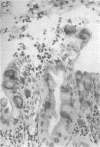Abstract
Twelve intestinal spirochete strains of porcine origin were characterized on the basis of their phenotypic properties, by multilocus enzyme electrophoresis, and by pathogenicity testing in gnotobiotic pigs. The spirochetes used included two strains of Serpulina hyodysenteriae (B204 and P18A), two strains of Serpulina innocens (B256 and 4/71), one strain from the proposed new genus and species "Anguillina coli" (P43/6/78), and seven non-S. hyodysenteriae strains recently isolated from United Kingdom pig herds with a history of nonspecific diarrhea and typhlocolitis. By multilocus enzyme electrophoresis, five of these were identified as S. innocens, one was identified as an unspecified Serpulina sp., and one was identified as "A. coli." S. hyodysenteriae B204 and P18A, "A. coli" P43/6/78 and 2/7, and three (22/7, P280/1, and 14/5) of the five S. innocens field isolates induced mucoid feces and typhlocolitis in gnotobiotic pigs. None of the other spirochetes produced clinical signs or large intestinal pathology in this model. The "A. coli" strains induced a more watery diarrhea, with lesions present more proximally in the large intestine, than did the other pathogenic spirochetes. S. innocens 22/7 was also tested for pathogenicity in hysterotomy-derived pigs that had previously been artificially colonized with a spirochete-free intestinal flora and shown to be susceptible to swine dysentery. Despite effective colonization, strain 22/7 did not produce any disease, nor was there any exacerbation of large intestinal pathology or clinical signs when pigs with an experimentally induced existing colitis caused by Yersinia pseudotuberculosis were superinfected with strain 22/7. Certain non-S. hyodysenteriae spirochetes are therefore capable of inducing disease in gnotobiotic pigs, but their role as primary or opportunistic pathogens in conventional pigs remains equivocal.
Full text
PDF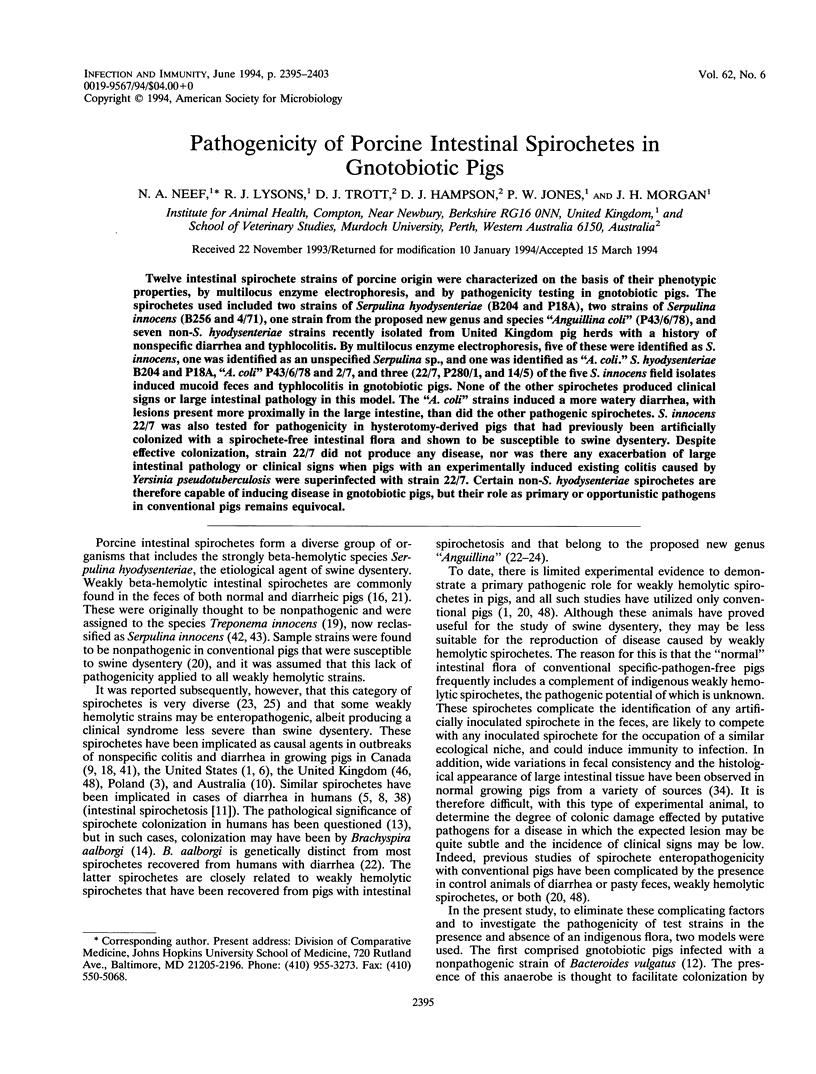
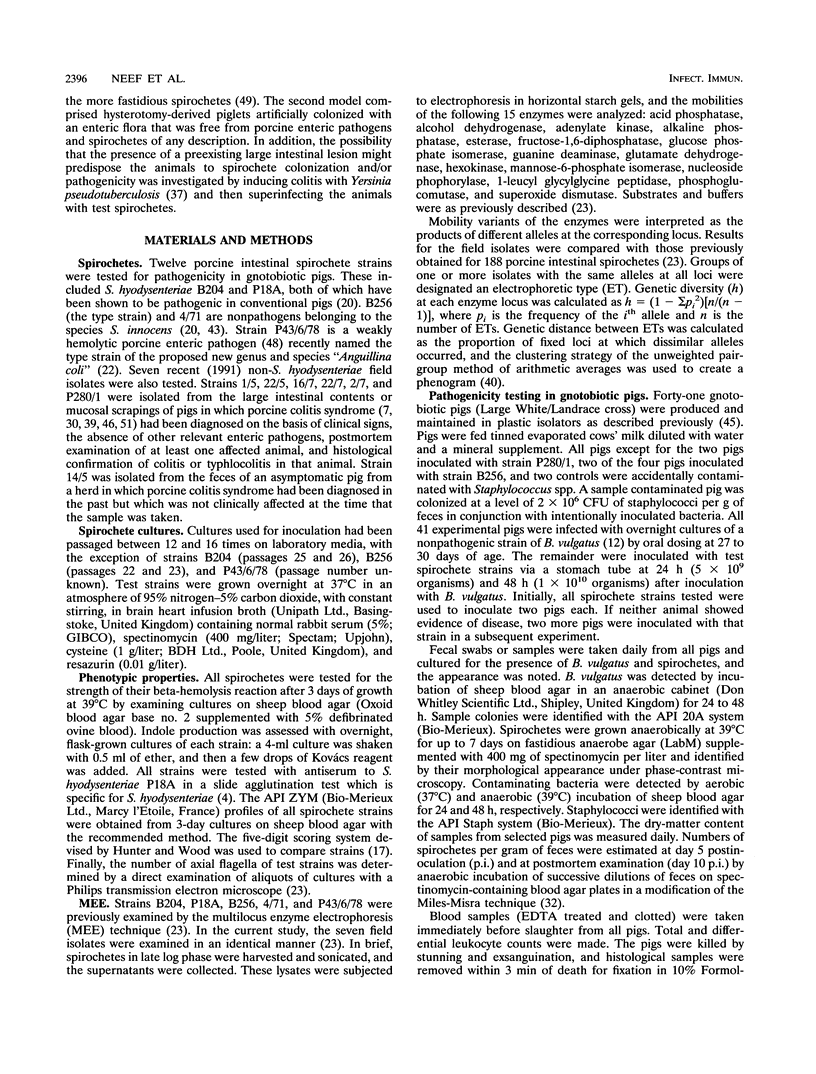
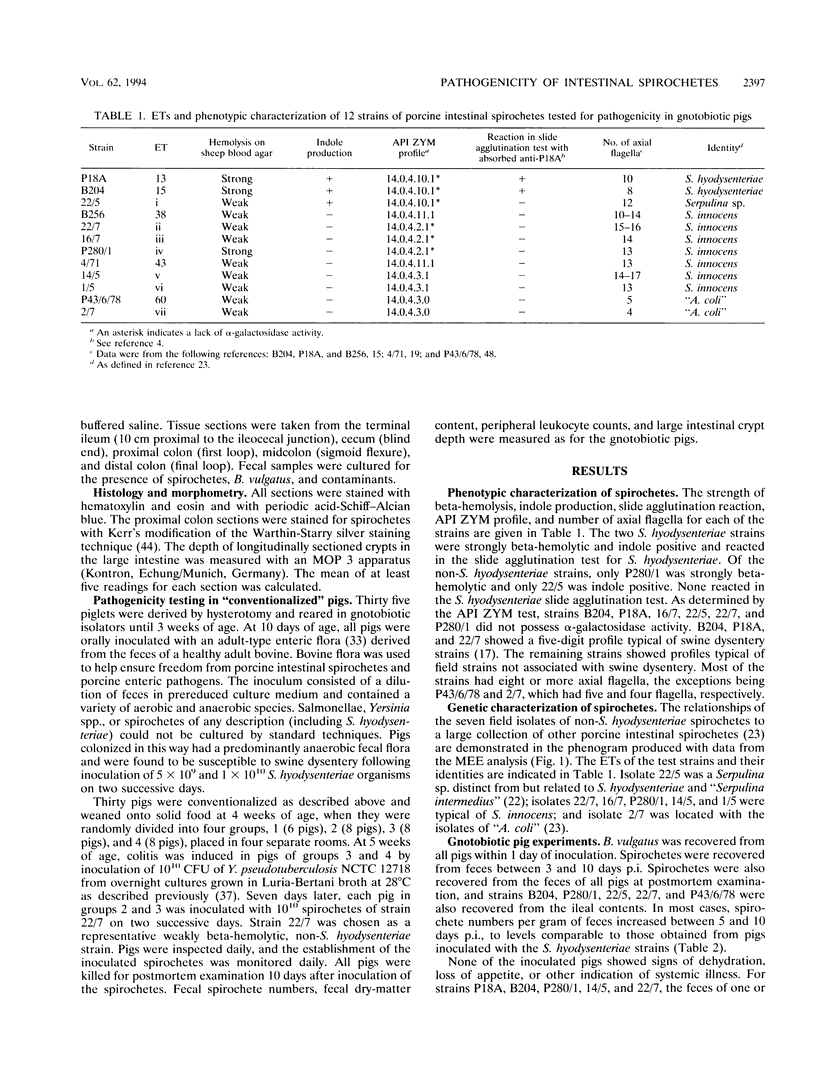
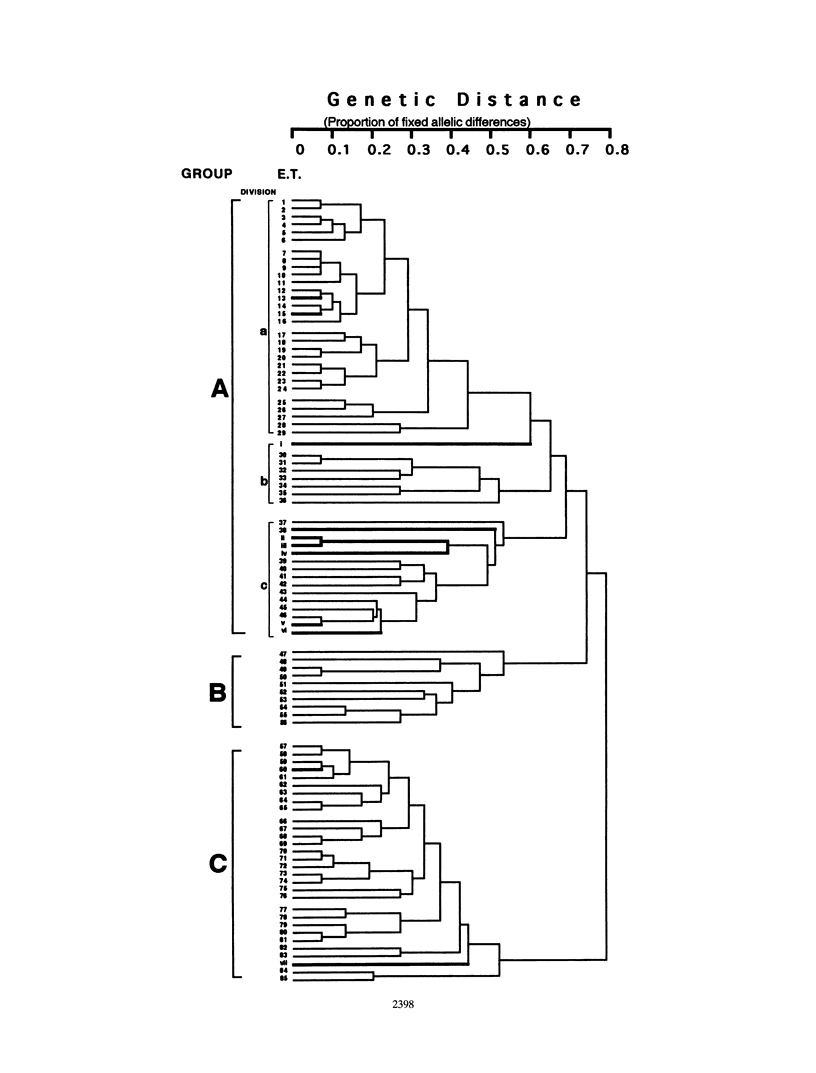
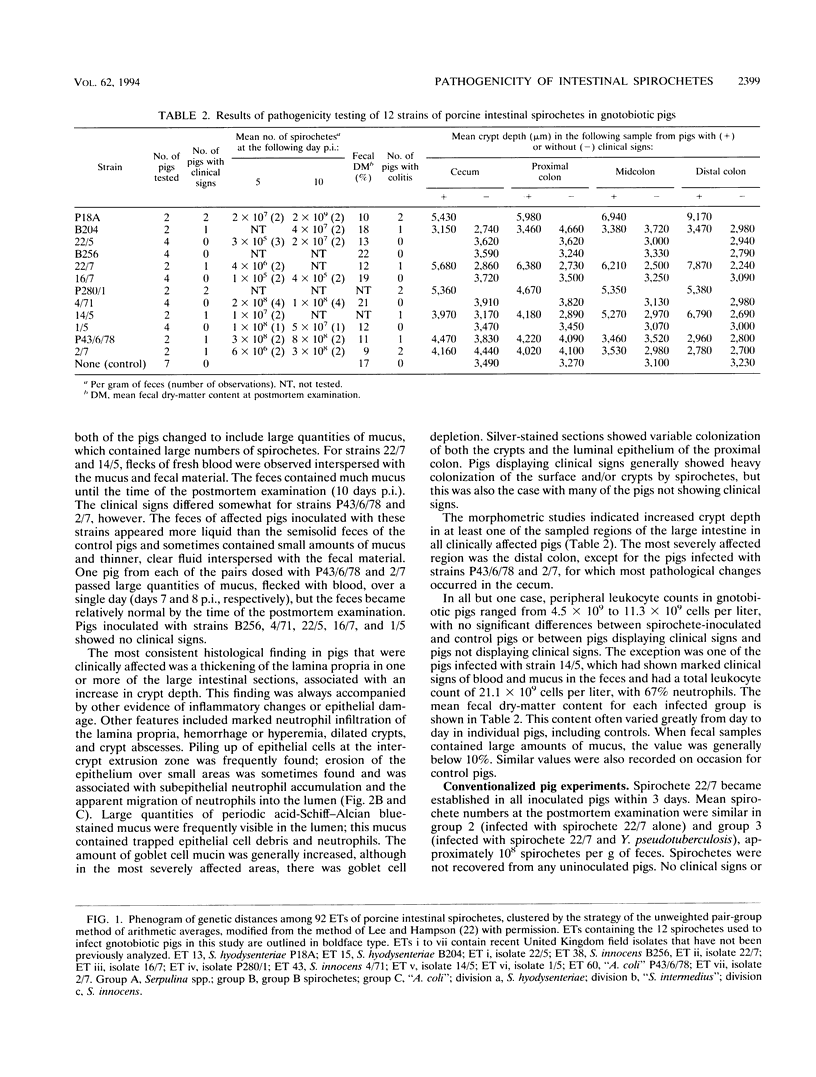
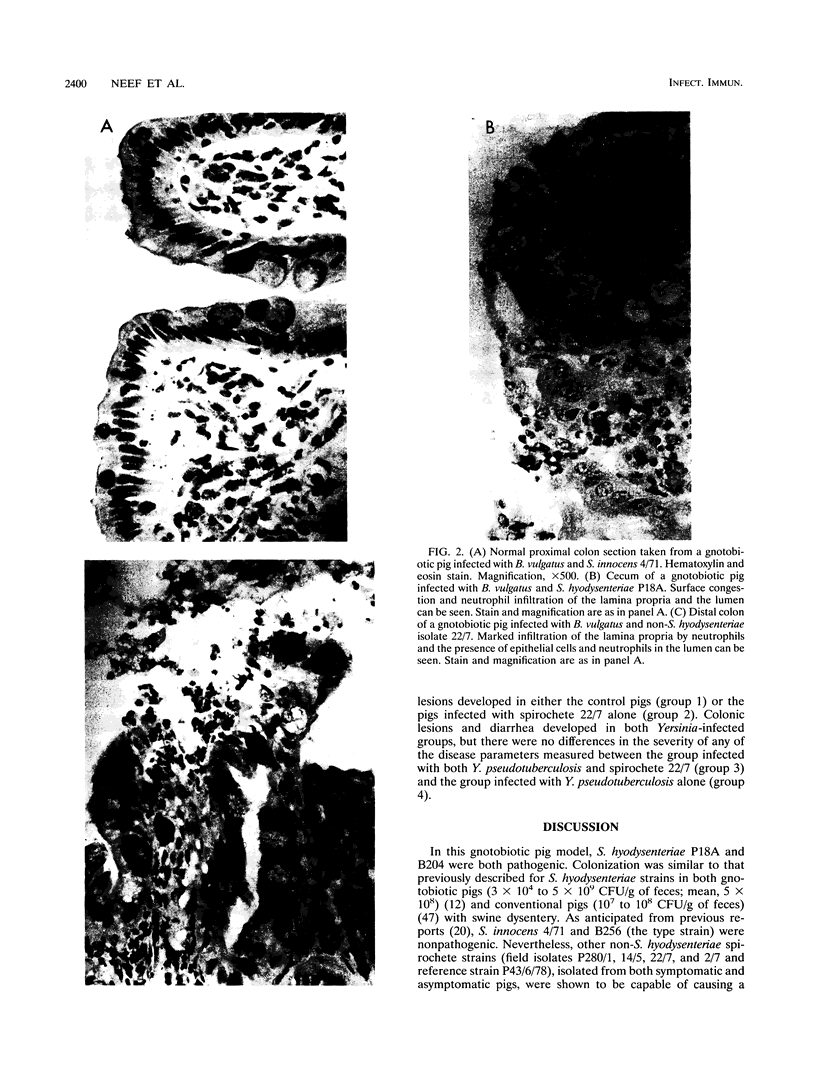
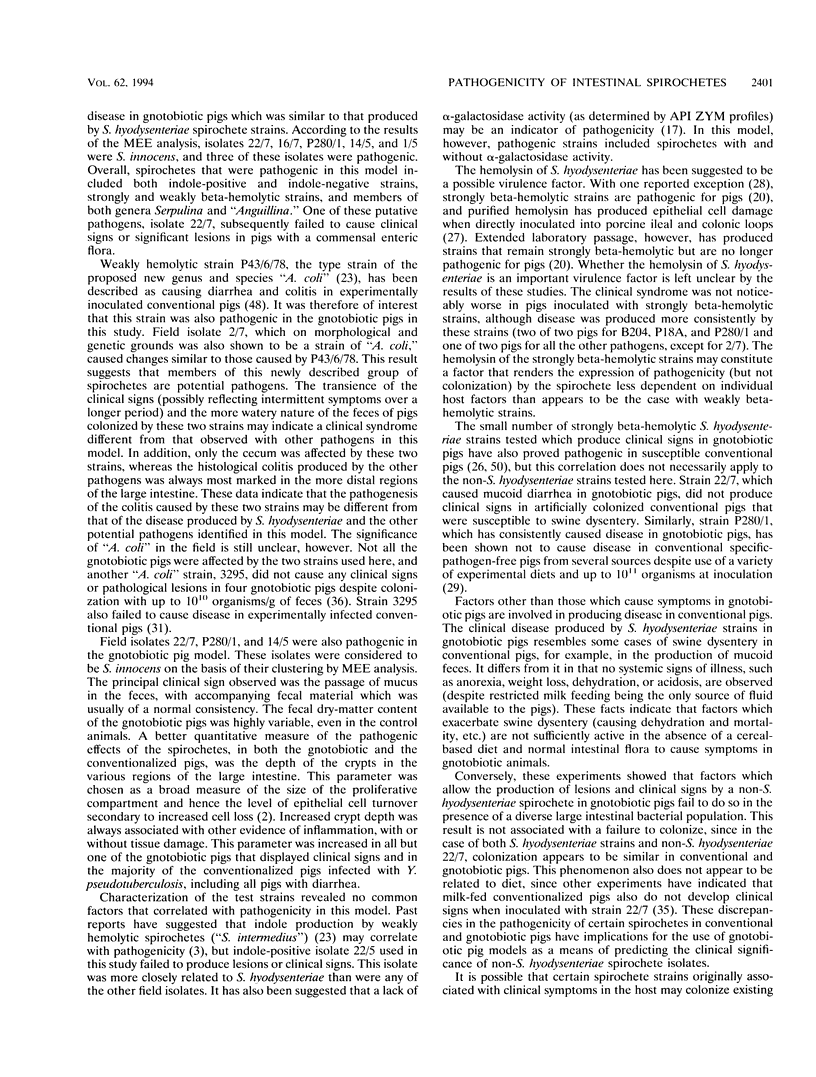
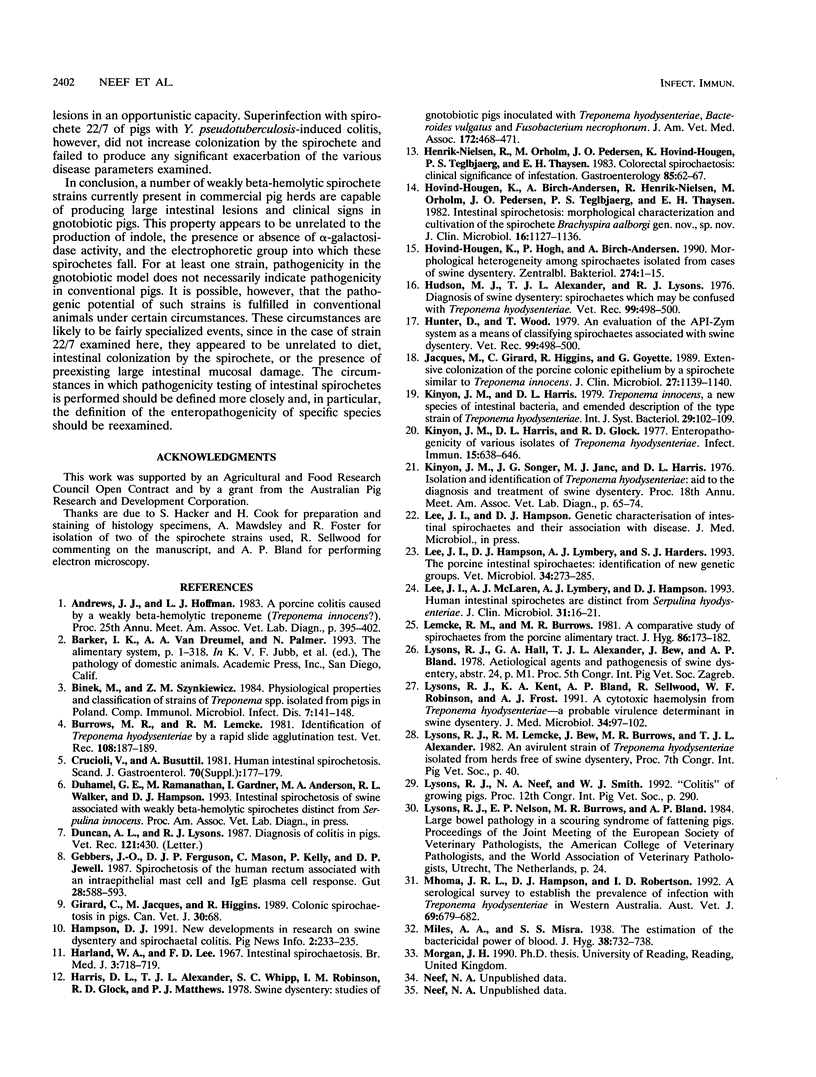
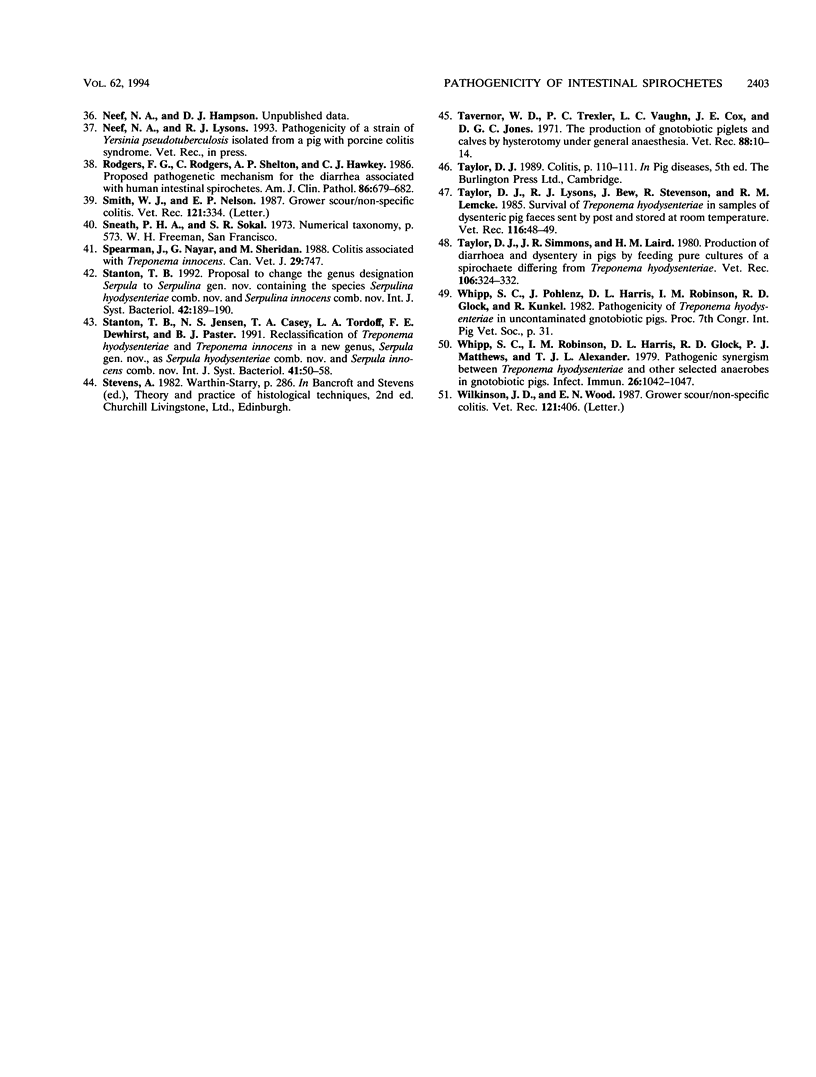
Images in this article
Selected References
These references are in PubMed. This may not be the complete list of references from this article.
- Binek M., Szynkiewicz Z. M. Physiological properties and classification of strains of Treponema sp. isolated from pigs in Poland. Comp Immunol Microbiol Infect Dis. 1984;7(3-4):141–148. doi: 10.1016/0147-9571(84)90019-5. [DOI] [PubMed] [Google Scholar]
- Burrows M. R., Lemcke R. M. Identification of Treponema hyodysenteriae by a rapid slide agglutination test. Vet Rec. 1981 Feb 28;108(9):187–189. doi: 10.1136/vr.108.9.187. [DOI] [PubMed] [Google Scholar]
- Crucioli V., Busuttil A. Human intestinal spirochaetosis. Scand J Gastroenterol Suppl. 1981;70:177–179. [PubMed] [Google Scholar]
- Duncan A. L., Lysons R. J. Diagnosis of colitis in pigs. Vet Rec. 1987 Oct 31;121(18):430–430. doi: 10.1136/vr.121.18.430-a. [DOI] [PubMed] [Google Scholar]
- Gebbers J. O., Ferguson D. J., Mason C., Kelly P., Jewell D. P. Spirochaetosis of the human rectum associated with an intraepithelial mast cell and IgE plasma cell response. Gut. 1987 May;28(5):588–593. doi: 10.1136/gut.28.5.588. [DOI] [PMC free article] [PubMed] [Google Scholar]
- Girard C. Québec. Colonic spirochetosis in piglets. Can Vet J. 1989 Jan;30(1):68–68. [PMC free article] [PubMed] [Google Scholar]
- Harland W. A., Lee F. D. Intestinal spirochaetosis. Br Med J. 1967 Sep 16;3(5567):718–719. doi: 10.1136/bmj.3.5567.718. [DOI] [PMC free article] [PubMed] [Google Scholar]
- Harris D. L., Alexander T. J., Whipp S. C., Robinson I. M., Glock R. D., Matthews P. J. Swine dysentery: studies of gnotobiotic pigs inoculated with Treponema hyodysenteriae, Bacteroides vulgatus, and Fusobacterium necrophorum. J Am Vet Med Assoc. 1978 Feb 15;172(4):468–471. [PubMed] [Google Scholar]
- Hovind-Hougen K., Birch-Andersen A., Henrik-Nielsen R., Orholm M., Pedersen J. O., Teglbjaerg P. S., Thaysen E. H. Intestinal spirochetosis: morphological characterization and cultivation of the spirochete Brachyspira aalborgi gen. nov., sp. nov. J Clin Microbiol. 1982 Dec;16(6):1127–1136. doi: 10.1128/jcm.16.6.1127-1136.1982. [DOI] [PMC free article] [PubMed] [Google Scholar]
- Hovind-Hougen K., Høgh P., Birch-Andersen A. Morphological heterogeneity among spirochetes isolated from cases of swine dysentery. Zentralbl Bakteriol. 1990 Oct;274(1):1–15. doi: 10.1016/s0934-8840(11)80970-9. [DOI] [PubMed] [Google Scholar]
- Hudson M. J., Alexander T. J., Lysons R. J. Diagnosis of swine dysentery: spirochaetes which may be confused with Treponema hyodysenteriae. Vet Rec. 1976 Dec 18;99(25-26):498–500. doi: 10.1136/vr.99.25-26.498. [DOI] [PubMed] [Google Scholar]
- Jacques M., Girard C., Higgins R., Goyette G. Extensive colonization of the porcine colonic epithelium by a spirochete similar to Treponema innocens. J Clin Microbiol. 1989 May;27(5):1139–1141. doi: 10.1128/jcm.27.5.1139-1141.1989. [DOI] [PMC free article] [PubMed] [Google Scholar]
- Kinyon J. M., Harris D. L., Glock R. D. Enteropathogenicity of various isolates of Treponema hyodysenteriae. Infect Immun. 1977 Feb;15(2):638–646. doi: 10.1128/iai.15.2.638-646.1977. [DOI] [PMC free article] [PubMed] [Google Scholar]
- Lee J. I., Hampson D. J., Lymbery A. J., Harders S. J. The porcine intestinal spirochaetes: identification of new genetic groups. Vet Microbiol. 1993 Mar;34(3):273–285. doi: 10.1016/0378-1135(93)90017-2. [DOI] [PubMed] [Google Scholar]
- Lee J. I., McLaren A. J., Lymbery A. J., Hampson D. J. Human intestinal spirochetes are distinct from Serpulina hyodysenteriae. J Clin Microbiol. 1993 Jan;31(1):16–21. doi: 10.1128/jcm.31.1.16-21.1993. [DOI] [PMC free article] [PubMed] [Google Scholar]
- Lemcke R. M., Burrows M. R. A comparative study of spirochaetes from the porcine alimentary tract. J Hyg (Lond) 1981 Apr;86(2):173–182. doi: 10.1017/s0022172400068881. [DOI] [PMC free article] [PubMed] [Google Scholar]
- Lysons R. J., Kent K. A., Bland A. P., Sellwood R., Robinson W. F., Frost A. J. A cytotoxic haemolysin from Treponema hyodysenteriae--a probable virulence determinant in swine dysentery. J Med Microbiol. 1991 Feb;34(2):97–102. doi: 10.1099/00222615-34-2-97. [DOI] [PubMed] [Google Scholar]
- Nielsen R. H., Orholm M., Pedersen J. O., Hovind-Hougen K., Teglbjaerg P. S., Thaysen E. H. Colorectal spirochetosis: clinical significance of the infestation. Gastroenterology. 1983 Jul;85(1):62–67. [PubMed] [Google Scholar]
- Rodgers F. G., Rodgers C., Shelton A. P., Hawkey C. J. Proposed pathogenic mechanism for the diarrhea associated with human intestinal spirochetes. Am J Clin Pathol. 1986 Nov;86(5):679–682. doi: 10.1093/ajcp/86.5.679. [DOI] [PubMed] [Google Scholar]
- Smith W. J., Nelson E. P. Grower scour/non-specific colitis. Vet Rec. 1987 Oct 3;121(14):334–334. doi: 10.1136/vr.121.14.334-b. [DOI] [PubMed] [Google Scholar]
- Spearman J. G., Nayar G., Sheridan M., Sheridan, Health H. S. Manitoba. Colitis associated with Treponema innocens in pigs. Can Vet J. 1988 Sep;29(9):747–747. [PMC free article] [PubMed] [Google Scholar]
- Stanton T. B., Jensen N. S., Casey T. A., Tordoff L. A., Dewhirst F. E., Paster B. J. Reclassification of Treponema hyodysenteriae and Treponema innocens in a new genus, Serpula gen. nov., as Serpula hyodysenteriae comb. nov. and Serpula innocens comb. nov. Int J Syst Bacteriol. 1991 Jan;41(1):50–58. doi: 10.1099/00207713-41-1-50. [DOI] [PubMed] [Google Scholar]
- Stanton T. B. Proposal to change the genus designation Serpula to Serpulina gen. nov. containing the species Serpulina hyodysenteriae comb. nov. and Serpulina innocens comb. nov. Int J Syst Bacteriol. 1992 Jan;42(1):189–190. doi: 10.1099/00207713-42-1-189. [DOI] [PubMed] [Google Scholar]
- Tavernor W. D., Trexler P. C., Vaughan L. C., Jones D. G. The production of gnotobiotic piglets and calves by hysterotomy under general anaesthesia. Vet Rec. 1971 Jan 2;88(1):10–14. doi: 10.1136/vr.88.1.10. [DOI] [PubMed] [Google Scholar]
- Taylor D. J., Lysons R. J., Bew J., Stevenson R., Lemcke R. M. Survival of Treponema hyodysenteriae in samples of dysenteric pig faeces sent by post and stored at room temperature. Vet Rec. 1985 Jan 12;116(2):48–49. doi: 10.1136/vr.116.2.48. [DOI] [PubMed] [Google Scholar]
- Taylor D. J., Simmons J. R., Laird H. M. Production of diarrhoea and dysentery in pigs by feeding pure cultures of a spirochaete differing from Treponema hyodysenteriae. Vet Rec. 1980 Apr 12;106(15):326–332. doi: 10.1136/vr.106.15.326. [DOI] [PubMed] [Google Scholar]
- Whipp S. C., Robinson I. M., Harris D. L., Glock R. D., Matthews P. J., Alexander T. J. Pathogenic synergism between Treponema hyodysenteriae and other selected anaerobes in gnotobiotic pigs. Infect Immun. 1979 Dec;26(3):1042–1047. doi: 10.1128/iai.26.3.1042-1047.1979. [DOI] [PMC free article] [PubMed] [Google Scholar]
- Wilkinson J. D., Wood E. N. Grower scour/non-specific colitis. Vet Rec. 1987 Oct 24;121(17):406–406. doi: 10.1136/vr.121.17.406-b. [DOI] [PubMed] [Google Scholar]




